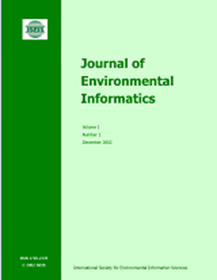Dye Pollutant Removal from Synthetic Wastewater: A New Modeling and Predicting Approach Based on Experimental Data Analysis, Kriging Interpolation Method, and Computational Intelligence Techniques
IF 5.4
1区 环境科学与生态学
Q1 ENVIRONMENTAL SCIENCES
引用次数: 0
Abstract
In the present study, a new approach by coupling the interpolation method with computation-based technique (data-mining algorithms and an optimization algorithm) is introduced for modeling and optimization removal of Reactive Orange 7 (RO7) dye removal from synthetic wastewater. To this end, four significant factors like pH, electrolyte concentration, current density, and electrolysis time are considered as input variables. Thus, modeling of RO7 removal is implemented using eight data mining algorithms including multi- variate linear regression (MLR), ridge regression (RR), multivariate nonlinear regression (MNLR), artificial neural network (ANN), classification and regression tree (CART), k nearest neighbor (KNN), random forest (RF), and support vector machine (SVM). These al- gorithms require a large data set for creating reliable results. However, creating a large number of experimental data request consuming high cost and time. Hence, the interpolation methods of kriging (KRG) and inverse distance weight (IDW) are applied for generating more data, whereas KRG has more accuracy than IDW by increasing the 47.080, 36.914, and 1.77% in MAE, RMSE, and R values, res- pectively. Then, the data mining algorithms are used for modeling the decolorization efficiency (DE) based on the original data and new data from KRG. It is found that using new data leads to significantly increasing accuracy (94.47, 96.43, 1.52, and 2.77% for MAE, RMSE, R and R2, respectively) of DE modeling. Also, SVM has demonstrated the highest accuracy out of all data mining algorithms (by in- creasing the 97.13, 98.30, and 14.42% in MAE, RMSE, and R2 values, respectively). Another challenge in the removal of RO7 from synthetic wastewater is predicting the maximum removal amount and optimal input variables. For this purpose, the hybrid of SVM and whale optimization algorithm (WOA) is employed. Finally, SVM-WOA has predicted the maximum of DE (91%) by optimal values of 4.2, 1.5 g/L, 4.2 mA/cm2, and 18 min for pH, C, I, and Time, respectively. In light of the high performance of the introduced approach for modeling removal process and predicting optimal conditions of removal process, this approach can be suggested for the removal of other pollutants from wastewater when the number of experimental data set is limited.合成废水中染料污染物去除:一种基于实验数据分析、Kriging插值方法和计算智能技术的新建模和预测方法
在本研究中,引入了一种将插值方法与基于计算的技术(数据挖掘算法和优化算法)相结合的新方法,对合成废水中活性橙7 (RO7)染料的去除进行建模和优化。为此,将pH、电解液浓度、电流密度、电解时间四个重要因素作为输入变量。因此,采用多变量线性回归(MLR)、岭回归(RR)、多变量非线性回归(MNLR)、人工神经网络(ANN)、分类与回归树(CART)、k近邻(KNN)、随机森林(RF)和支持向量机(SVM)等8种数据挖掘算法实现了RO7去除的建模。这些算法需要大量的数据集来产生可靠的结果。然而,创建大量的实验数据需要耗费大量的成本和时间。因此,为了生成更多的数据,我们采用了克里格插值(KRG)和逆距离权重插值(IDW)方法,其中KRG比IDW更准确,其MAE、RMSE和R值分别提高了47.080、36.914和1.77%。然后,基于KRG的原始数据和新数据,利用数据挖掘算法对脱色效率进行建模。研究发现,使用新数据可以显著提高DE建模的准确率(MAE、RMSE、R和R2分别为94.47、96.43、1.52和2.77%)。此外,SVM在所有数据挖掘算法中显示出最高的准确性(MAE、RMSE和R2值分别增加了97.13、98.30和14.42%)。从合成废水中去除RO7的另一个挑战是预测最大去除率和最佳输入变量。为此,采用了支持向量机和鲸鱼优化算法(WOA)的混合算法。最后,SVM-WOA预测了pH、C、I和Time分别为4.2、1.5 g/L、4.2 mA/cm2和18 min时DE的最大值(91%)。鉴于所引入的方法在建模去除过程和预测去除过程最优条件方面的高性能,在实验数据集数量有限的情况下,该方法可用于废水中其他污染物的去除。
本文章由计算机程序翻译,如有差异,请以英文原文为准。
求助全文
约1分钟内获得全文
求助全文
来源期刊

Journal of Environmental Informatics
ENVIRONMENTAL SCIENCES-
CiteScore
12.40
自引率
2.90%
发文量
7
审稿时长
24 months
期刊介绍:
Journal of Environmental Informatics (JEI) is an international, peer-reviewed, and interdisciplinary publication designed to foster research innovation and discovery on basic science and information technology for addressing various environmental problems. The journal aims to motivate and enhance the integration of science and technology to help develop sustainable solutions that are consensus-oriented, risk-informed, scientifically-based and cost-effective. JEI serves researchers, educators and practitioners who are interested in theoretical and/or applied aspects of environmental science, regardless of disciplinary boundaries. The topics addressed by the journal include:
- Planning of energy, environmental and ecological management systems
- Simulation, optimization and Environmental decision support
- Environmental geomatics - GIS, RS and other spatial information technologies
- Informatics for environmental chemistry and biochemistry
- Environmental applications of functional materials
- Environmental phenomena at atomic, molecular and macromolecular scales
- Modeling of chemical, biological and environmental processes
- Modeling of biotechnological systems for enhanced pollution mitigation
- Computer graphics and visualization for environmental decision support
- Artificial intelligence and expert systems for environmental applications
- Environmental statistics and risk analysis
- Climate modeling, downscaling, impact assessment, and adaptation planning
- Other areas of environmental systems science and information technology.
 求助内容:
求助内容: 应助结果提醒方式:
应助结果提醒方式:


